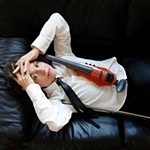Dual Perceptions
Two Blanton Museum exhibitions, two artists, and a conversation about how to look at art
By Andrew Long, Fri., July 27, 2012
The Blanton Museum of Art has two terrific survey exhibitions on display with no connection except the adjoining galleries they occupy. "The Human Touch: Selections From the RBC Wealth Management Art Collection" presents a premier corporate collection of contemporary art, while "The Collecting Impulse: Fifty Works From Dorothy and Herbert Vogel" showcases a New York couple's personal collection of contemporary art acquired over a half-century. Such complex diversity demanded a conversation about art, so I called on artist John Swanger, formerly based in Los Angeles, now living in Austin (www.johnswanger.org). John's the smartest guy in the room, although his gracious meditative demeanor conceals it well. His paintings are infused with this intelligent, calmed brilliance, richly layered in a colored minimalist hue. He was the perfect conversation partner for these two inspiring shows.
Austin Chronicle: Do you have any specific method for navigating an exhibition space?
John Swanger: I'll often walk through first to get an overview and then begin at a particular point to look in a more focused way.
AC: I find myself going in the opposite direction, a rebellious move of sorts, as in: "Please don't lay it out like breadcrumbs for me to follow." That said, the first thing I noticed was that Lynda Benglis over there. The cerulean blue got me – so evocative. I look at the Elizabeth Murray next to it and think, "That's a little too much for me right now."
JS: Well that Elizabeth Murray is actually by Lynda Benglis, too, but don't worry; I actually did the same thing. [Laughter] There is an Elizabeth Murray around the corner, an incredible gem and in some ways one of my favorite pieces in this show.
AC: There are so many commanding small works in this exhibition. The Vogels had quite the grasp for collecting work that was so out of the ordinary for the time.
JS: There is a great quote at the entrance of the exhibition from Herbert Vogel, something to the effect of: "Art is information, and it helps us find our way in our times."
AC: Now I love those breadcrumbs ...
JS: [The Vogels] collected approximately 4,000 pieces, with 2,500 distributed equally to museums in all 50 states, the Blanton being one. The National Gallery of Art will steward the remaining collection. It is mind-blowing. What started out as a personal and intimate collection ended up as a collection of mythic proportions.
AC: They were such a seemingly simple couple, yet collected so sophisticatedly.
JS: I love Herbert Vogel saying, "We bought [works of art] because we didn't understand them. We liked them. A real work of art you never entirely understand, and if I waited until I thought I understood, I would have never have bought anything." So he's putting that right up front. To not know and to wonder and puzzle and be curious is life.
AC: That curiosity is so relational and expanding. The deeper intimacy informs, reflects back, and illuminates one's own reflection.
JS: I totally agree, and how works of art seem to change over time. That's the timeless quality of art, because it's not fixed in a point in time. It is alive in every moment, and you continually re-experience what the artist experienced making the art.
AC: As a viewer, it is so important to move around the room and constantly change perspective. I find it provides a deeper understanding of the work.
JS: For artists that is very, very natural. We are so used to being that way in our own studios, and in exhibition spaces, it is very natural to move forward, back, and sideways, looking at things from different angles and across the room. When I say I was really moved by a work, often it means emotionally, but also literally, because it caused me to move around the room more.
AC: This wall full of Richard Tuttle's watercolor drawings pulls me in really close, then I notice there is so much more. Like looking at a star that is actually a galaxy. These drawings remind me the universe is expanding. Tuttle presents tiny core samples – a scalpel slice – though it might leap off the page and envelop us here.
JS: A blob of thin blue and a blob of thin red could imply all kinds of things. Our mind's tendency is to want to project onto abstract work and make stories or narratives so we can relate it to something we understand. These are a great example of what Herb Vogel talks about: I don't understand it; I don't know what it is or what is in Tuttle's mind. Part of it, I believe, has to do with how small a gesture can be and still function as art. There is so little to hang on to, yet I find them engaging.
AC: Here we are, about to cross over into the "Human Touch" exhibition, from gray walls to cream ...
JS: The nature of the Vogels' art collection requires a quiet stillness, and the gray walls support that.
AC: The first thing I noticed is "Human Touch" doen't trot out lots of the same ol' blue-chip artists, though I do want to discuss that Chuck Close over there. Second, considering our post-Facebook world, we are bombarded with images of people constantly. In this exhibition, I am aware of the artwork's subject matter, and seemingly, the subjects are aware of me. As in this Roland Fischer photograph: If you stare into the subject's eyes, wherever you walk she keeps looking at you, even though you know her gaze is fixed in one place. A Mona Lisa effect. True for many of these artworks, I am either being looked at, or the subject is looking away.
JS: Portraits are easy to relate to; they are recognizable images. This exhibition has a lot of diversity: the people portrayed, artists represented, styles and approaches of the work. [But] it seems to lack the diversity of nudity, gay art, or even an attempt to expand the notion of what a portrait might be, or what human presence might be, or how you could depict a person or presence of a person other than depicting the physical form.
AC: It is a corporate collection. Perhaps that has something to do with it. This Chuck Close lithograph is especially unique. I think it has to do with the upper lip being almost like a mustache. As it starts to break apart, there is something elegantly messy about it. Comprised of a bunch of little squares, yet it reads like big globs of impasto paint.
JS: That is a great observation. I love it, too. The fact that it is done in his style with cellular elements like little fields of energy that seem utterly random. It coalesces into a pixilated, kind of weird, out-of-focus, slightly hallucinogenic image of a face, depending how far away you are.
AC: The Vik Muniz next to it is so complementary.
JS: The Close and Muniz are fantastic together because of the method and the way in which it relates – the fact that it's originally made out of chocolate syrup and looks like a beautiful sepia-toned black-and-white photograph of a crowd scene. There's this very effective shift between the abstracted chocolate smear and the illusion of the image constantly fluctuating in and out of those dual perceptions.
AC: In the larger context, dual perceptions permeate both exhibitions: a personal and a corporate collection, seeing and being seen, what art gets included and what doesn't, human presence vs. physical form ...
JS: Yes, these two exhibitions are so different from one another and a lot to take in.
AC: They are an odd pairing, though art is such a powerful agent for observation. Or as Herb Vogel said, "Art is information, and it helps us find our way."
JS: Everything in the world is a mirror for ourselves, right? Art is, of course, as well.
"The Human Touch: Selections From the RBC Wealth Management Art Collection" and "The Collecting Impulse: Fifty Works From Dorothy and Herbert Vogel" run through Aug. 12 at the Blanton Museum of Art, MLK at Congress. For more information, call 471-7324 or visit www.blantonmuseum.org.











